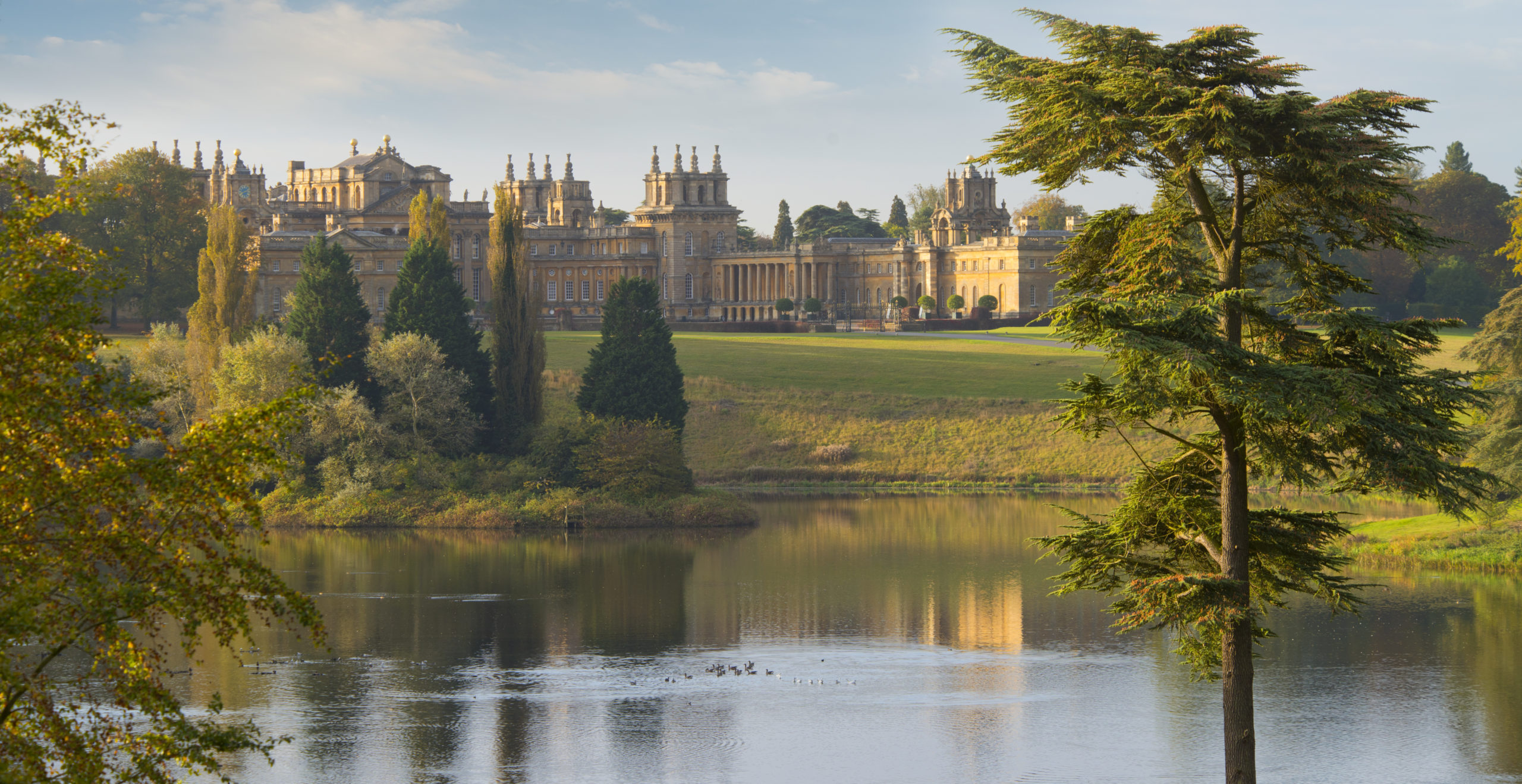In Xanadu did Kubla Khan a stately pleasure dome decree…
How do the abodes of today’s ultra-rich compare with the established residences of royalty? If you’re looking for splash and pizzazz, especially with respect to raw square footage, today’s ultra-rich mostly don’t measure up to the royal families and rulers of yesteryear. On the other hand, when you consider cost per square foot, with the notable exception of the Chinese Emperors of old ensconced in the Forbidden City and erstwhile French royalty who lived at Versailles, some of today’s billionaires are living higher on the hog than potentates in their palaces.
Table of Contents
Contents
Royal Palaces and Castles
Blenheim Palace
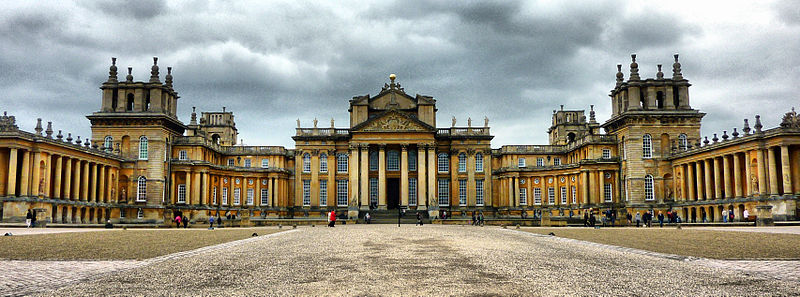
145,000 square feet and 187 rooms: $281 million or $1,937/sq ft
More modest than Buckingham and Windsor Palaces, but still impressive in its own right, Blenheim Palace, named after the tide-changing 1704 Battle of Blenheim during the War of the Spanish Succession, had its cornerstone laid June 1705. When the first Duke of Marlborough won a key victory over the forces of Louis XIV of France on the fields of Blenheim in Bavaria, Queen Anne of England gave him and his heirs the 2,000 acre royal manor at Woodstock in Oxfordshire to build a suitably magnificent residence—“on behalf of a grateful nation,” as the time-tested expression goes.
And so began the saga of an extended boondoggle, because no one thought to set a budget. Parliament cut off all funds for the project in 1711 after it had overrun the duke’s initial cost guesstimate by 600%. While this financial fiasco was taking shape, the duke and duchess got caught up in political intrigue that led Queen Anne to dismiss them from court, so they went into self-imposed exile for two years. Nonetheless, construction resumed in 1716, and Blenheim Palace was completed in 1722.
Maintenance of the palace has been an albatross around the neck of the family ever since. Consuelo Vanderbilt, whose American money rescued Blenheim from bankruptcy when she married the 9th Duke of Marlborough in 1895, called it “an expensive absurdity,” and in light of its 145,000 square feet of floor space, she added, “it is so strange that in so great a house there should not be one really livable room.”
Blenheim is probably most famous as the birthplace of Sir Winston Spencer Churchill (1874-1965), the justly celebrated Prime Minister of Britain who saw the country through World War II. On the whole, however, the families of the Marlborough dukes have had a somewhat checkered history. The current holder of the title since 2014 is no exception: the adolescence and young adulthood of Jamie Blandford, the 12th Duke of Marlborough, whose father once threatened to disinherit him, reminds one more of a certain music festival in New York than of Woodstock, Oxfordshire. Drug-addled, with three stretches in prison and twenty convictions to his name, he was certainly the proverbial black sheep. But he eventually turned the right corner and has, since 2008, resided at Blenheim and devoted himself to the duties of managing the estate and its polo team.
If one considers the current value of the property, the old adage that there are three things that matter in real estate—location, location, and location—seems to apply. Blenheim Palace is out in the boonies, so to speak, whereas Buckingham Palace is in the heart of London. Blenheim’s $281 million price tag translates to $1,937/sq ft, whereas Buckingham’s worth, at over $5 billion, is of a different order. Let’s drive over and take a look, shall we?
Pardon me, do you have any Grey Poupon?
Buckingham Palace
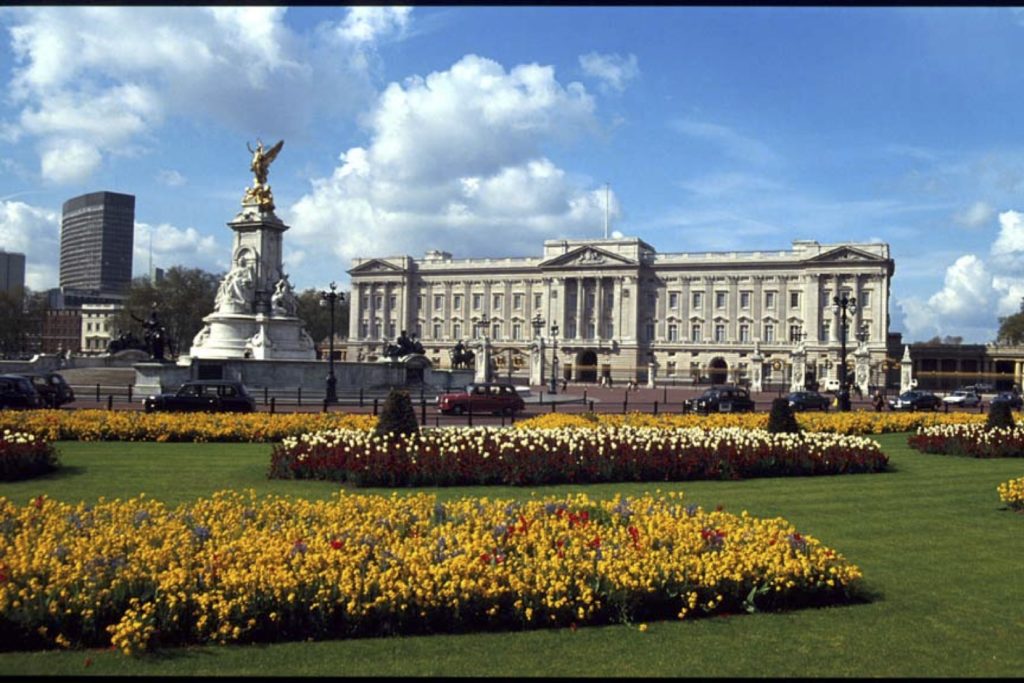
828,821 square feet and 775 Rooms: $5,289,404,160 or $6,382/sq ft
Buckingham Palace is, today, the central location and showpiece of the United Kingdom’s constitutional monarchy. It has grown into this status since it became the official London residence of British monarchs in 1837, but it was not always so. George III purchased it as “Buckingham House” in 1731 for Queen Charlotte, his wife, because it was close to St. James’s Palace, where many official royal functions were held at the time. Fourteen of George III’s fifteen children were born in Buckingham House.
When George IV ascended to the throne in 1820, he reconstructed the house, with the intention of keeping it as an occasional residence, but he changed his mind as the work progressed, and around 1826 decided to have his architect, John Nash, turn it into a palace. The north and south wings of the house were demolished and rebuilt on a larger scale with the Marble Arch, commemorating British victories at Trafalgar and Waterloo, as the centerpiece of a bigger courtyard. By 1829, however, cost overruns led to John Nash being fired for his extravagance and replaced by Edward Blore, who finished the project.
Queen Victoria was the first British monarch to take up residence in Buckingham Palace in 1837, and the monarchy has resided there ever since. Nonetheless, after her marriage, Queen Victoria and Prince Albert discovered a lot of shortcomings in the design, not the least being the absence of nurseries for children and guest rooms for visitors. The only solution was to move the Marble Arch to the north-east corner of Hyde Park and build a fourth wing, creating a quadrangle. The cost was covered by the sale of George IV’s Royal Pavilion at Brighton. Subsequently, Blore also added an attic floor to the main palace and decorated it externally with marble friezes originally made for Nash’s Marble Arch. This renovation was completed in 1847.
The forecourt of the palace, where the Changing of the Guard takes place, was created in 1911 as part of the Victoria Memorial, and the façade on the east side, which was deteriorating, was replaced in 1913 in accordance with a design by Sir Aston Webb. All of the renovations to the building and the grounds that produced Buckingham Palace in the form we know it today were completed just before the outbreak of the First World War in 1914.
Buckingham Palace’s 775 rooms include 19 state rooms, 52 royal and guest bedrooms, 188 staff bedrooms, 92 offices, and 78 bathrooms, plus a variety of rooms for other purposes. The building is 355 feet across the front, 395 feet deep (including the central courtyard), and 80 feet tall. It’s internal square footage comes to an impressive 828,821 square feet and its current value is a monumental $5,289,404,160, which comes out to $6,382/sq ft. Not too shabby!
Forbidden City
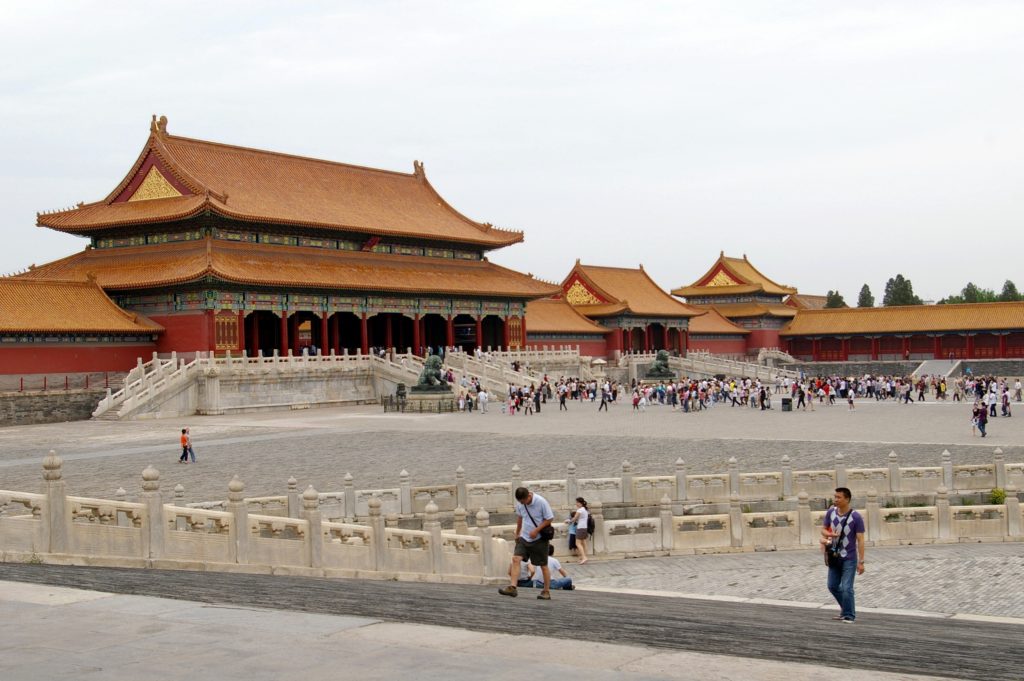
1,614,587 sq ft, 980 buildings, and 8,707 rooms: $69.66 billion or $43,144/sq ft
Construction of The Forbidden City was started in 1406 and completed in 1420, during the early Ming Dynasty. It was built by over 1 million workers, including more than 100,000 craftsmen. The Forbidden City is the largest medieval palatial structure in the world and the best preserved imperial palace in China. Located in Beijing, it served as the imperial palace complex of the Ming (1368-1644) and Qing (1644-1912) dynasties, and was the home of 24 emperors.
The Forbidden City got its name simply because, as the home of the feudal emperors of China who regarded themselves as “sons of heaven,” entrance was forbidden to ordinary people. When the last Chinese emperor left the palace in 1925, The Forbidden City simply became the Palace Museum, open to the public. It is now one of the most popular tourist attractions in China, hosting about 14 million visitors each year, with a maximum of 80,000 visitors each day.
The legend about the city is that Emperor Yongle, who built it, had originally planned for it to contain 10,000 rooms, but before he issued this order, he had a dream in which the God of Heaven was angry because the number of palaces in heaven was also 10,000. As a result, he decreed that The Forbidden City was to be built with half a room less than planned. This half room is supposedly a small room on the west side of the first floor of the Wenyuan Pavilion. Of course, this is mere legend. In medieval Chinese architecture, a square space among four pillars in a hall is what counts as one room, and by the latest count in 1972, there are 8,707 rooms in The Forbidden City.
The Forbidden City contains 980 buildings in over 70 palace compounds. It covers about 0.28 of a square mile, of which slightly over 37 acres (more precisely, 1,614,587 sq ft) are floor space. From north to south it is 3,153 feet long, and it is 2,470 feet wide from east to west. It is surrounded by a wall that is over 30 feet high and two miles long. This wall, in turn, is surrounded by a moat that is over 170 feet wide.
The cost to build The Forbidden City today comes in at a staggering $69.66 billion, which, even given its size, translates to $43,144/sq ft, making it the second most expensive palace (per square foot) in the world. As for the most expensive palace per square foot, for sheer excess, the trophy goes to the French… but we’ll get there!
National Palace
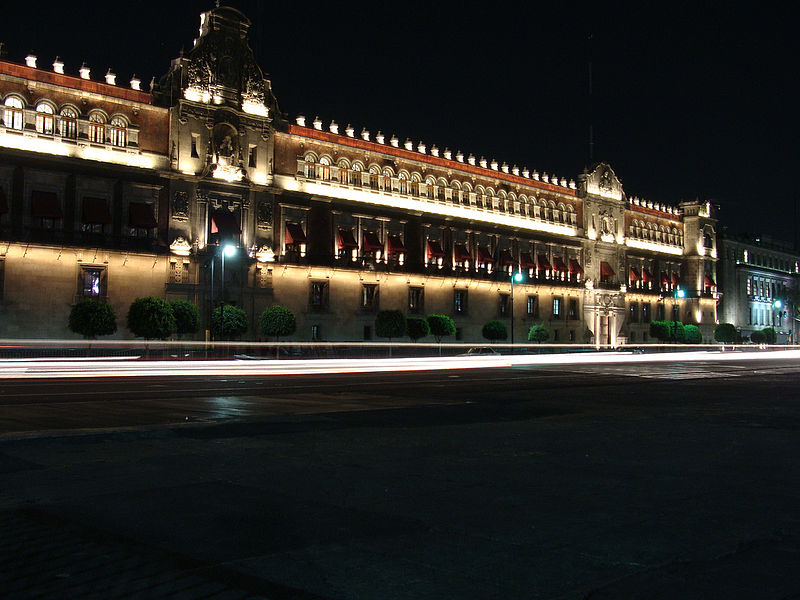
430,000 sq ft: $200 million U.S. or $465/sq ft
The Palacio Nacional houses the offices of the President of Mexico and the Federal Treasury and is the seat of Mexico’s federal government. It also contains one of the country’s most important libraries—the Biblioteca Miguel Lerdo de Tejada—and most famously—and the reason it’s such a tourist attraction—stunning murals and artworks by one of Mexico’s most famous artists, Diego Rivera.
The first palace on the present site was built by the Aztec emperor Moctezuma II (Montezuma) in the early 1500s. Along with many other Aztec structures in the area, it was destroyed by the Spanish conquistador Hernán Cortés in 1521. Records of the lavishness of the Aztec palace were preserved in accounts of it that Cortés sent back in letters to the Spanish king. After destroying what the Aztecs had built, Cortés then hired two Spanish architects to design and oversee the building of a new structure on the spot as a fortress that had three internal courtyards. It became a family residence.
In 1562, the Spanish crown purchased the building from the Cortés family to serve as an abode for the viceroys of Nueva España (New Spain), and it maintained this purpose until Mexican independence was achieved. At the end of the period of Spanish colonization, the name of the structure was changed from Viceroy Palace to the one it currently holds: Palacio Nacional (National Palace).
Two items of note: (1) Hanging above the balcony over the center door at the front of the palace is the Campana de Dolores, a bell that was rung by Padre Miguel Hidalgo in the town of Dolores Hidalgo when the War of Independence started in 1810. The President of Mexico stands under this bell on the balcony on September 15th each year to shout ¡Viva México! in commemoration of Mexican independence; (2) Inside the palace are a variety of murals painted by Diego Rivera between 1929 and 1951 that tell the story of Mexican civilization from the mythical arrival of the Aztec feathered serpent god, Quetzalcóatl, to the time after the revolution. The nine murals that cover the north and east walls on the level of the palace immediately above the patio depict the life of Mexico’s indigenous peoples prior to the Spanish conquest.
The internal floor area of the palace covers 430,000 square feet and the cost to build it today would be around $200 million, which translates to $465 per square foot.
Schloss Neuschwanstein
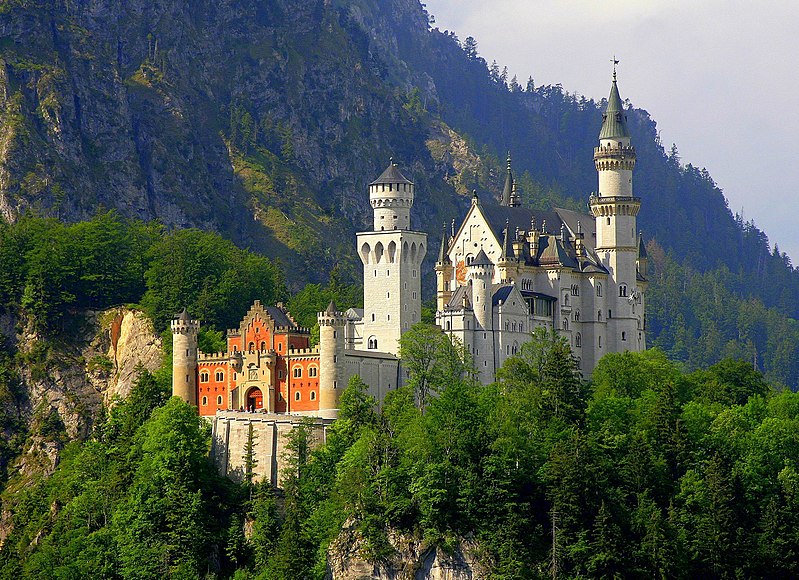
65,000 square feet and 200 rooms; $51,000,000 U.S. or $784/sq ft
Schloss Neuschwanstein is the most iconic castle in the world. It served as the model for the castle in Disney’s Sleeping Beauty and the castles at Disney theme parks, and it is infused with the mystique of its builder, Mad King Ludwig of Bavaria (1845-1886).
The castle’s genesis, apart from King Ludwig’s imaginative proclivities and peculiarities, was found in Bavarian political misfortune. Bavaria had allied itself with Austria in resisting Prussian expansion and, in 1866, lost a war and was forced to accept conditions that prohibited King Ludwig from controlling an army, ending his status as a sovereign ruler. Having acceded to the throne at the age of 18 in 1864, he considered this the biggest misfortune of his young life and, with political control taken from him, resolved to create a personal kingdom of castles and palaces over which he could rule.
Already given to flights of fancy, he gradually built an imaginary world around himself in which he could behave as if he were a real king. By the mid-1870s he was entirely nocturnal, playing out his fantasies at night and sleeping during the day. The new settings he devised for his dreams and conquests—including the famous castle that was begun in 1868 and completed after his death—were beyond the means of his private treasury. In 1885, foreign banks started threatening to seize his property. Unsurprisingly, Ludwig did not react rationally to these demands, so the Bavarian government, though it lacked a constitutional basis for doing so, declared him insane. In 1886, they deposed him, sequestering him at Berg Palace on Lake Starnberg, which they had outfitted with bars on the windows, turning it into a magisterial insane asylum. Mysteriously and suspiciously, before he’d even been there more than one day, his body was found floating in shallow water in Lake Starnberg, next to the body of his attending psychiatrist, Dr. Bernhard von Gudden. While Ludwig’s death was officially declared to be a suicide by drowning, many Bavarians to this day believe that he was murdered.
This mysterious tale provides a colorful backstory to the architecturally fantastical Schloss Neuschwanstein, itself located in an idyllic fairyland atop a rock ledge over the Pöllat Gorge in the Bavarian Alps. Construction on the castle began in the summer of 1868 as the ground was prepared for the foundation and a new access road was built. The foundation itself was laid in September 1869 and the construction of the castle commenced using the latest materials and building techniques. The foundations were cemented and light-colored limestone was used as a covering for the walls, which were made of brick. The Gateway Building was the first one completed in 1872, and work on the Palas containing the great hall was begun using the latest technology. When Ludwig requested that a throne room after construction was already underway, encased steel construction was used. Interior decoration and technical fittings were not completed until 1884. The castle as a whole was not finished until 1892, six years after Ludwig’s death, with simplified versions of the Bower and Square Tower substituted into the more extravagant original design.
The castle as it stands today has 65,000 square feet of floor space spread over 200 rooms. The cost of building it would run to about $51,000,000 U.S., which comes out as $784 per square foot.
Schönbrunn Palace
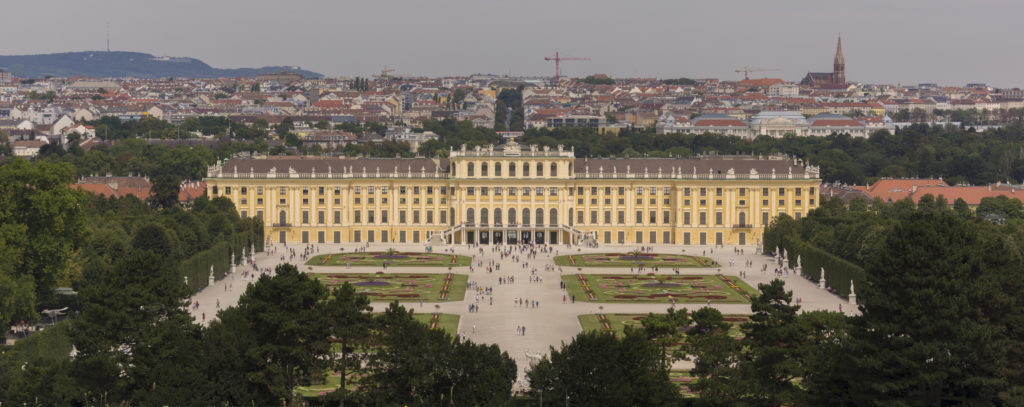
334,284 square feet and 1441 rooms: $501,426,000 or $1500/sq ft
Toward the end of the 1600s, the Rome-trained architect Johann Bernhard Fischer von Erlach was commissioned by Emperor Leopold I to design a hunting lodge for his Crown Prince, who later became Emperor Joseph I. This lodge supplanted the château de plaisance (country home—literally, pleasure house or pleasure castle) that had been built on the site for the widow empress Eleonora of Gonzaga in 1642. It grew into a palatial imperial residence over the course of the next hundred years. The palace now lies in Hietzing, the thirteenth municipal district of the City of Vienna.
The layout of the palace in its present form dates from the remodeling and rebuilding done during the reign of empress Maria Theresa in the 1740s-50s, who received the estate as a wedding gift. The neo-classical redecoration of the exterior was commissioned by the last Holy Roman Emperor, Francis II, who became Emperor of Austria in response to Napoleon being coronated as Emperor of France.
Francis Joseph I, the longest reigning emperor of Austria and king of the Austro-Hungarian Empire, was born at the Schönbrunn and lived most of his life there, passing in 1916. With the fall of the Hapsburg dynasty and the Austro-Hungarian monarchy in 1918, ownership of the palace defaulted to the Austrian Republic and the palace was preserved as a museum.
While the palace was requisitioned from 1945-55 to provide office space for the British Delegation and the Allied Commission for Austria after the Second World War, with the re-establishment of the Austrian Republic in 1955, it again became a museum. Since 1992, the building and gardens have been owned and maintained by an LLC, the Schloss Schönbrunn Kultur- und Betriebsgesellschaft, a company wholly-owned by the Republic of Austria.
The 1,441 room late-Baroque (Rococo) palace contains 334,284 square feet of floor space. The cost of building it today would slightly exceed one-half billion dollars ($501,426,000 U.S.), which converts to a substantial $1,500 per square foot.
Taj Mahal
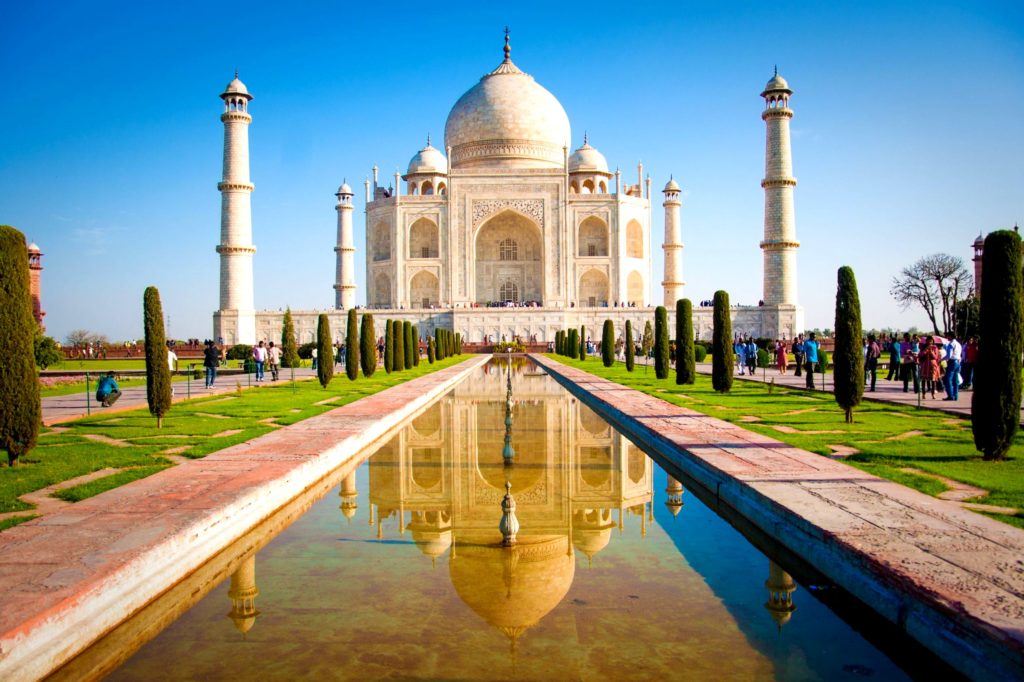
237,000 square feet and 560 rooms: $110.5 million or $466/sq ft
The Taj Mahal was built from 1632-1647 by the Mughal Emperor Shah Jahan as a mausoleum for his favorite wife, Mumtaz Mahal, who died giving birth to Jahan’s fourteenth child. It is located in Agra, India, and is the country’s most famous monument.
One of the legends surrounding the Taj Mahal, almost certainly false because there is absolutely no evidence for it, is that Jahan wanted the building to be a masterpiece that had no equal anywhere in the world, so he cut off the hands and gouged out the eyes of the craftsmen and artisans after their work was completed. While this gruesome myth adds to the mystique of the place, it has no basis in reality. As the disclaimer goes, no workmen were (willfully) harmed during the making of this monument.
Inside the structure are cenotaphs honoring Mumtaz Mahal and Shah Jahan. These cenotaphs are enclosed in an octagonal chamber that is decorated with a marble lattice and inlaid with semi-precious stones. The actual sarcophagi, however, are housed in a private room at garden level, below the cenotaphs.
The Taj Mahal represents the height of Mughal Islamic architecture and exhibits a flawless symmetry in accordance with the architectural axioms of the time. Minarets symmetrically flank the dome of the tomb and a central pool perfectly reflects the main building. The surrounding gardens are divided into quadrants and there are twin red sandstone buildings—a mosque on the east and a guesthouse on the west—that balance the geometry. The only odd feature is the placement of Shah Jahan’s cenotaph, which is located off the central axis of the complex, leading to speculation that it was not Jahan’s intention to be buried in the complex.
Another feature of the Taj Mahal that adds to its mystique and ambience is its changing hue in different light. It is light pink and pearly gray at dawn, a dazzling white in the noonday sun, and orange-bronze at sunset. At night, under a full moon, it can even appear a translucent blue. Of course, for these effects to be manifest, its marble façade must be cleaned regularly. Age and sooty pollution give the marble a brownish-yellow tinge, so when this starts to happen, mudpacks (called multiani mitti) are applied to the façade and washed off with brushes, whence the dullness vanishes and the glow returns.
Containing 560 rooms and a total of 237,000 square feet of floor space, if the Taj Mahal were to be built today, it would cost around $110,500,000 U.S., which translates to $466 per square foot.
Versailles
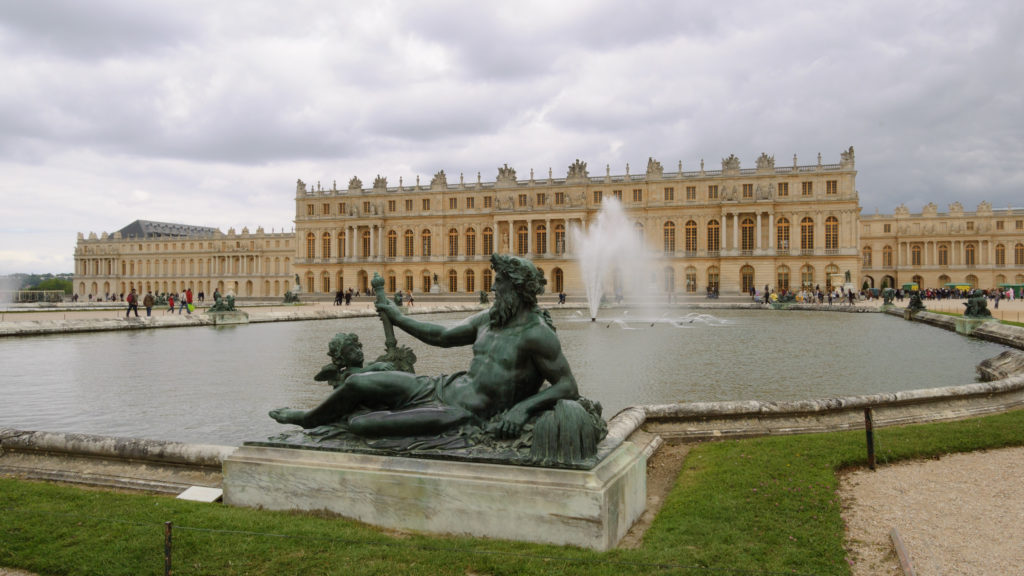
679,784 sq ft and 700 rooms; $50.7 billion or $74,583/sq ft
The Palace of Versailles, which is located about 12 miles west of Paris, France, was originally the site of a hunting lodge built by King Louis XIII in 1623. In 1661, inspired by the palatial residence of Nicolas Fouquet, the Château de Vaux-le-Vicomte, King Louis XIV recruited his own team of architects and craftsmen, and began to expand and renovate his father’s hunting lodge in three phases. This work lasted until 1715, the year of Louis XIV’s death.
The lodge, and then palace, was a favorite residence of the French kings, so the City of Versailles was the functional capital of France until the French Revolution. Kings Louis XV and XVI continued this tradition, but only made interior renovations to the structure. Louis XVI abandoned the palace, moving back to Paris when the revolution began in 1789. When this happened, Versailles was emptied of its contents and the population of the city took a nosedive.
When the French Revolution ended in 1799 and Napoleon seized power, crowning himself Emperor of France in 1804 and bringing an end to the First Republic, the Palace of Versailles was still empty. This changed when Napoleon decided to make it his summer residence from 1810 to 1814, but he did not restore it to its former glory. After Napoleon was exiled to the island of Elba, the Bourbon Restoration revived the French monarchy in a constitutional form (rather than absolute form of the Ancien Régime) with the monarchs constrained by the reforms of the revolution and the Napoleonic period. The House of Bourbon was replaced by the House of Orléans in the July Revolution of 1830, and it lasted until 1848, when another revolution broke out and the monarch, Louis Philippe, fled to England. This led to the declaration of the Second French Republic in 1848, which lasted all of four years.
In 1852, the President of the Second Republic, Louis-Napoleon Bonaparte, was declared Emperor of the French, re-establishing an imperial throne. He reigned as Napoleon III (his cousin, Napoleon II, was the disputed emperor for a few weeks at the age of three during the confusion that surrounded Napoleon’s abdication). Napoleon III reigned until 1870, when he was deposed during the Franco-Prussian War.
The Franco-Prussian War ended the French monarchy for good and ushered in a series of republican governments. The first of these, known (naturally) as the French Third Republic, lasted until the establishment of Vichy France during the Second World War when the country was overrun by the Nazis. The French Fourth Republic was established after the war, lasting from 1946 to 1958, when a series of crises in the French colonies, most notably the crisis provoked by the Algerian War of Independence, led to its dissolution by public referendum. This referendum established the French Fifth Republic, with a stronger presidency, under the leadership of Charles de Gaulle.
During all this time, Versailles persisted and underwent a variety of changes and updates, but it was never a royal residence again after the departure of Louis XVI. In 1837, it was declared the Museum of the History of France by King Louis-Philippe, and its rooms became repositories for displays of paintings and sculptures representing great events and individuals in the history of France. Throughout the vicissitudes of French history, these collections were expanded until, under the influence of its most eminent curator in the early twentieth century, Pierre de Nolhac, Versailles recovered its historical role as a monument to the Ancien Régime, when its central part was restored to the appearance it had once had as a royal residence.
A new restoration initiative was started in 2003. It began with a replanting of the gardens, which had lost over 10,000 trees during Hurricane Lothar in 1999, and included a restoration of the famous Hall of Mirrors, completed in 2006.
Today, the Palace of Versailles is owned by the French state and goes by the formal title “Public Establishment of the Palace, Museum and National Estate of Versailles.” It has been run with an independent administration and management supervised by the French Ministry of Culture since 1995.
The Palace of Versailles is massive and its extensive gardens even more so. The host to nearly 10 million visitors every year, the palace is comprised of 2,300 rooms and encompasses a staggering 679,784 square feet of floor space. The approximate cost to build the structure today would be $50.7 billion U.S. dollars. On a square-foot basis, this comes out to be $74,583, making Versailles the most expensive palace (per square foot) on the planet!
Windsor Castle
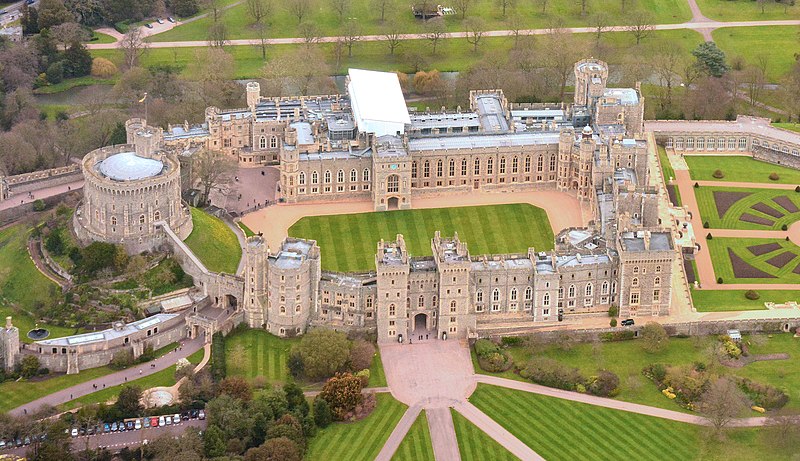
590,239 square feet and 1,000 rooms: $326 million U.S. or $552/sq ft
The honor of being the oldest and largest occupied castle in the world goes to Windsor Castle. William the Conqueror invaded England in 1066 and chose the site of Windsor Castle, overlooking the river Thames near Saxon hunting grounds, to guard the western approach to London. He started building the castle in 1070 and it was completed by 1086. It has since been the home to 39 monarchs, and is currently the abode of Queen Elizabeth II on most of her private weekends.
King Henry I established domestic quarters within the castle by 1110, and his grandson, Henry II, turned the castle into a palace at the end of the twelfth century, building two separate sets of royal apartments in the fortified enclosure, a Lower and Upper Ward. The Lower Ward was the official state residence in which visitors were received, but the north side of the Upper Ward contained a private residence for exclusive royal occupation.
Around the same time, Henry II also began replacing the original timber walls of the castle with stone. In 1170, the original keep was rebuilt as the Round Tower, and the whole outer perimeter was redone over the following sixty years. During his long reign in the thirteenth century, Henry III rebuilt the Lower Ward and added a large chapel built around a courtyard with a cloister, improved the private royal residence in the Upper Ward, and completed the stone walls around the Lower Ward.
Starting in the 1350s and up until his death in 1377, Edward III spent 50,000 pounds to transform Windsor from a military fortification into a gothic palace. William of Wykeham, Bishop of Winchester, was the construction foreman, overseeing the redesign of the Upper Ward to include an inner gatehouse with cylindrical towers and royal apartments with separate rooms for the King and Queen on the north side of the inner courtyard. These renovations continued six years beyond his death, into the reign of his grandson, Richard II. Apart from the further addition of a gallery by Edward IV and some updating of the King’s and Queen’s great chambers, Edward III’s modifications of the royal residences remained unchanged until the 1600s.
The castle fell into disrepair over time, and in the 1570s, during the reign of Elizabeth I, a long list of improvements were made and a long gallery was built that overlooked the North Terrace. In the 1800s, this gallery was merged into the Royal Library.
Charles II, who was invited back from Scotland to reclaim his father’s throne after the dissolution of the Protectorate Parliament in 1660, updated the royal residences so that, by 1684, they had become the most luxurious baroque state apartments in England. These royal residences stayed virtually the same for another century until George III redid several rooms on the north side of the courtyard in a neoclassical style. He also added a new music room and a new dining room in the east range of the Upper Ward and, in 1796, began the exterior transformation of Windsor Castle into a gothic palace.
This gothic transformation was continued by George IV, who ascended to the throne in 1820. To give the Castle a more formidable appearance, the Round Tower was made taller and the exterior reclad with heavy masonry, adding more battlements and towers. George IV’s restoration of Windsor Castle was so thorough that very little remained to be done. During the long reign of Queen Victoria in the nineteenth century, the Grand Staircase was rebuilt, a new private chapel was constructed at the eastern end of St. George’s Hall, and the Royal Mews and riding school on the south side of the Castle were completed.
Beyond maintenance and upkeep, little happened to Windsor Castle until near the end of the twentieth century. In November of 1992, a fire started in the private chapel Queen Victoria had built, and it quickly gutted the chapel, the Crimson Drawing Room, the State Dining Room, and destroyed the ceilings of St. George’s Hall and the Grand Reception Room. Restoration work began immediately, guided by the Restoration Committee chaired by Prince Philip (1921-2021), the Duke of Edinburgh, who was the husband of Queen Elizabeth II. The most badly damaged areas, St. George’s Hall included, were redesigned in a modern gothic style, while the other parts were restored to the design of George IV. The restoration work was completed in 1997, almost exactly five years after the fire.
Windsor Castle hosts between one and two million paid visitors each year. It contains an impressive 1,000 rooms that collectively comprise 590,239 square feet of floor space. Since property is not as expensive outside of London, the cost of building it today on the same spot would be about $326 million U.S., which converts to $552 per square foot.
Winter Palace

645,835 square feet and 1500 rooms: $6.44 billion or $9972/sq ft
The Winter Palace in Saint Petersburg (which was Leningrad for a time that is now thankfully past) was the official home of the Russian Emperors from 1732 to 1917. The current Winter Palace is actually the fourth of that name. It is located next to the site of Peter the Great’s original Winter Palace, between the Palace Square and the Palace Embankment on the Neva River. Today the palace and its grounds form the Hermitage Museum.
Peter the Great and his family occupied the first imperial residence on the current site of the Winter Palace in 1708. It was a wooden home built in the Dutch style, but replaced in 1711 by a stone structure, which was the second Winter Palace. The remains of the latter building form the foundations for the Hermitage Theater today, and parts of the original palace have been restored for the public to see.
In 1731, Peter’s descendant, Empress Anna Ioannovna, commissioned the court architect Francesco Bartolomeo Rastrelli to create a new and larger palace on the site. This third Winter Palace was completed in 1735, but had this form for just 17 years before Rastrelli was commissioned by Empress Elizaveta Petrovna to expand the structure. After two years of playing around with ideas to adapt the third palace, Rastrelli finally proposed totally rebuilding it, and the Empress approved his new design in 1754.
The fourth Winter Palace was almost complete when Catherine the Great ascended to the throne in 1762. Catherine removed the aging Rastrelli from the project, but his exterior design remains virtually unaltered even today. The square building has an internal courtyard that can be accessed from the Palace Square through three archways, and the richly decorated façade of the building has two levels of filigreed ionic columns and parapets decorated with vases and statues (the stone decorations later being replaced with metal substitutes in 1892-1902). The front of the palace rises to a height of 73 feet and city regulations to this day prevent any building in downtown St. Petersburg from exceeding this height.
Interior additions and improvements continued throughout the eighteenth and nineteenth centuries. Giacomo Quarenghi and Ivan Starov created a new enfilade of state rooms overlooking the Neva River in the 1780s and 1790s. The architect Carlo Rossi was commissioned by Emperor Nicholas I in 1826 to add a gallery commemorating the War of 1812.
As Christmas 1837 approached, a fire broke out inside the palace and spread rapidly, destroying much of the interior. The priceless art collections of the Hermitage were saved by the quick thinking of Nicholas I, who ordered the destruction of the three passages between the two buildings. Nicholas then ordered that the palace be reconstructed within one year, a nearly impossible feat given the construction techniques of the day, but accomplished under the direction of architects Vasily Stasov, who restored the luxurious interior, and Alexander Brullov, who added new and more contemporary designs.
Alexander II, who was assassinated in 1881, was the last of the Russian Tsars to use the Winter Palace as his main residence. It became clear that the building was too large to secure against attack (an assassination attempt through bomb detonation in 1880 had damaged several rooms and killed eleven guards). Consequently, both Alexander III and Nicholas II retreated to suburban palaces. The Winter Palace was still used for ceremonies and receptions, however. The last major event hosted by the Imperial Family was held there in 1903.
The Bloody Sunday Massacre took place in Palace Square in 1905. Thousands of striking workers gathered to protest their conditions to the Tsar, whose security forces were given orders by their leaders to fire at will. Nicholas II was not responsible for this tragedy, but it marked the beginning of the end of imperial power in Russia. Nicholas II abdicated in 1917 after the February revolution, and the Winter Palace became the seat of the provisional government under Alexander Krenskiy. The Bolshevik Revolution, when the Winter Palace was stormed in October 1917, was actually against this provisional power rather than the Imperial family. In the resultant chaos, some of the palace’s treasures were looted—including, and perhaps not surprisingly, the wine cellars—but the Hermitage remained untouched.
The Winter Palace was declared part of the Hermitage Museum on October 17, 1917, and even though the Bolsheviks removed all imperial symbols from the palace and used it as a museum of the Revolution, the restoration project in the late 1940s and early 1950s to remedy the extensive damage done to the building during the Siege of Leningrad, began the process of restoring the splendor of the palace to the days of Imperial Russia.
The Winter Palace draws around 4 million visitors each year to see its treasures and enjoy the artworks in the Hermitage Museum. The palace itself contains 1,500 rooms that cover 645,835 square feet of floor space. The cost of building the same structure on the site today would come to a whopping $6.44 billion U.S., which prices out at an impressive $9,972 per square foot.
Private Mansions and Estates
The mansions of the ultra-wealthy of today, especially those of the nouveau riche, do not have the long history and distinction of royal palaces, so the interest they hold, apart from the opulence they exemplify, is mostly due to the celebrity of their occupants. While these residences don’t generally have the raw square footage of the palaces and castles of royalty, if we exempt The Forbidden City and the Palace of Versailles from consideration, some of these homes cost markedly more per square foot!
Antilia (Ambani)
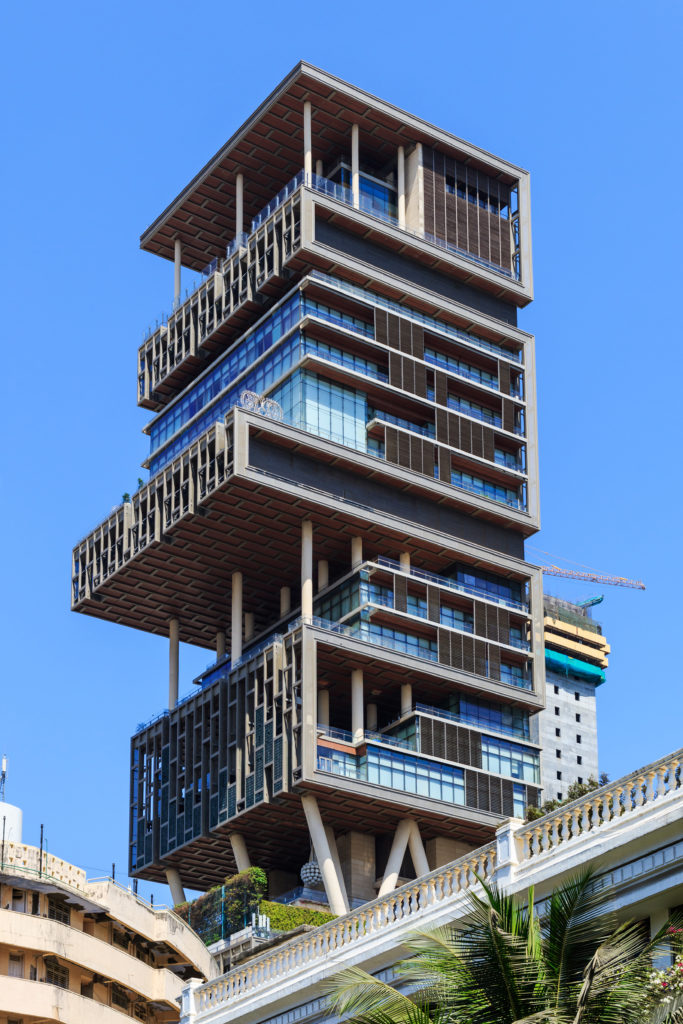
400,000 sq ft and 27 floors: $2 billion or $5,000/sq ft
Considered the world’s most expensive private residence, since the autumn of 2011, Antilia has been the home of the Indian billionaire Mukesh Ambani and his family. It is located along Billionaires’ Row in Mumbai and is named after the mythical island, Antillia. The structure has 27 storeys, but each floor has the height of two in a normal building, so it stands 568 feet tall, more like a building that is at least 54 storeys high. It was designed by two American architecture firms, Dallas-based Perkins and Will, and Los Angeles-based Hirsch Bedner Associates. It can withstand an earthquake measuring 8 on the Richter Scale.
Antilia is the epitome of opulent excess, featuring a variety of luxuries, like a 168-car garage, a ballroom, nine high-speed elevators, terrace gardens, a 50-seat theater, a swimming pool, a spa and health center, a Hindu temple, three helipads, its own air-traffic control, a salon, an ice-cream parlor, several guest suites, and a snow-room that spits out man-made snowflakes from the walls if the heat in Mumbai is too much for its pampered residents. The top six floors are reserved as private space for the Ambani family.
The land on which Antilia is built has a controversial history. It was originally the property of an orphanage called Currimbhoy Ebrahim Khoja Yateemkhana and the home for 60 orphans. In 2002, the trust that owned the property requested permission to sell the land, and this permission was granted by the charity commissioner three months later. The problem was that the land was allocated for the purpose of educating underprivileged Khoja children, yet it was sold to a commercial entity controlled by Mukesh Ambani. What’s even worse is that the land was sold for $3 million when it was worth $21 million. The sale was further in direct contravention of the Wakf Act and this led to a series of court cases, the last of which was dismissed in 2019. In any case, there remains a widespread public perception that Antilia is emblematic of the lack of empathy that rich Indians have for the poor in their country.
While Antilia is by far the largest, most expensive, and lavish private residence on the planet considered as a whole structure, it nonetheless is not the most expensive per square foot. That honor goes to Jeff Bezos’s primary home. Even so, at 400,000 square feet and $2 billion U.S., it still comes in at a pricey $5,000 per square foot.
Biltmore Estate (Vanderbilt)
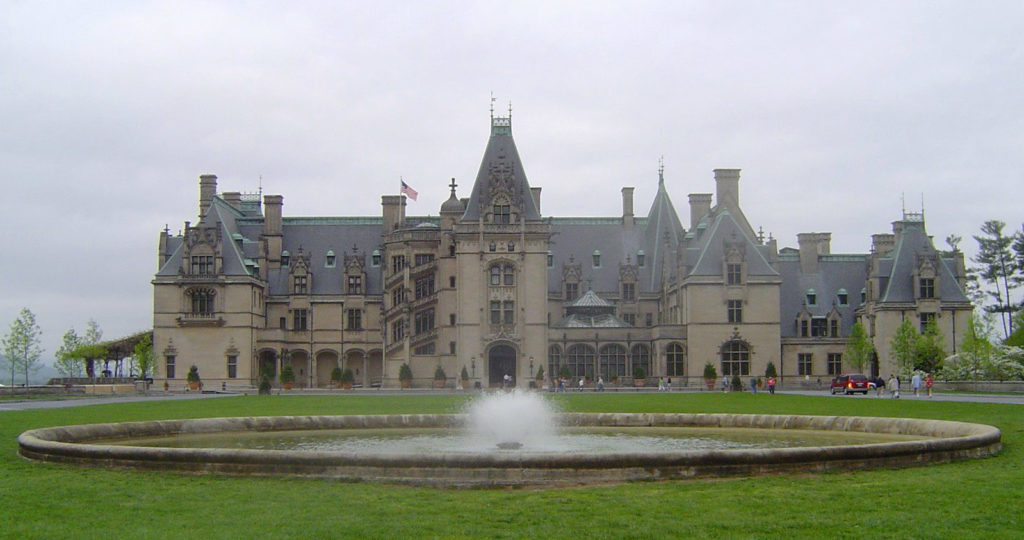
178,926 square feet and 250 rooms: $175,000,000 or $978/sq ft
The Biltmore House, located on an 8,000 acre estate in Asheville, North Carolina, is the largest private home in America. Built by George and Edith Vanderbilt between 1889 and 1895, it is one of the most ostentatious examples of the mansions of the Gilded Age. The property still belongs to the Vanderbilt family, but the estate is overseen by The Biltmore Company, a trust that was set up by the family, and it has become a public attraction with restaurants, gift shops, a winery, and a luxury hotel.
George Vanderbilt commissioned the New York City architect Richard Morris Hunt to design the house in the style of a French Renaissance château, and Frederick Law Olmsted to do the landscaping for the estate. The interior of the mansion has four floors, not including the basement. It is equipped with an Otis elevator, centrally-controlled clocks, fire alarms, a call bell system for attendants, and forced-air heating. Its 250 rooms include 35 bedrooms for family and guests, 43 bathrooms, 65 fireplaces, and 3 kitchens.
The main rooms of the house are located on the ground (first) floor. There is a marbled entrance hall, to the right of which is an octagonal sunken winter garden room surrounded by archways and having a ceiling of sculptured wood and multifaceted glass. The Banquet Hall is 72 feet long and 42 feet wide, with a 70 foot barrel-vaulted ceiling, making it the largest room in the house. It contains a dining table that seats 64 guests. At the far end of the Banquet Hall is the Music Room, which houses an organ gallery. To the left of the entrance hall is a 90-foot-long tapestry gallery that leads to the Library, which is two storeys high and contains 10,000 volumes in eight languages.
The second floor is accessed by a cantilevered Grand Staircase consisting of 107 steps that spiral around a four-storey wrought-iron chandelier requiring 72 light bulbs. The Living Hall on the second floor is a portrait gallery displaying a variety of large-scale masterpieces. The Vanderbilts’ suite of rooms is also on the second floor. George’s gilded bedroom in the south tower connects to Edith’s Louis-XV-style oval-shaped bedroom in the north tower through an ornate Jacobean carved oak paneled sitting room with a decorative ceiling. The suite of private rooms also contains a room with Damask draperies and wallpaper, a room with paintings by Claude Lorrain (one of Vanderbilt’s favorite artists), a Tyrolean chimney room, and another room done in the style of Louis XV.
The third and fourth floors have a variety of guest rooms that are named after the furniture designers or artists featured in them, as well as 21 bedrooms that were occupied by housemaids, laundresses, and other female attendants. Male attendants did not live in the house, but rather in rooms above the horse stables. The fourth floor of the mansion has an Observatory with a wrought-iron balcony overlooking the estate.
The house also had a “Bachelor’s Wing” that was entered through the Billiard Room, in which secret door panels on either side of the fireplace led to private quarters where female guests and staff members were not permitted. It contained a Smoking Room and a Gun Room that housed Vanderbilt’s trophies and his gun collection.
The basement level was home to a variety of activity rooms, including a gymnasium with fitness equipment, a 70,000 gallon swimming pool with underwater lighting, and a bowling alley. It also housed the service area where many attendants worked: the main kitchen for food preparation, a pastry kitchen, a rotisserie kitchen, large walk-in refrigerators, laundry rooms, the staff dining hall, and additional bedrooms for the attendants paid to run the estate.
This massive mansion contains 178,926 square feet of floor space, which, at a total cost of $175,000,000 to build today, comes to $978 per square foot.
Breakers ( Vanderbilt)
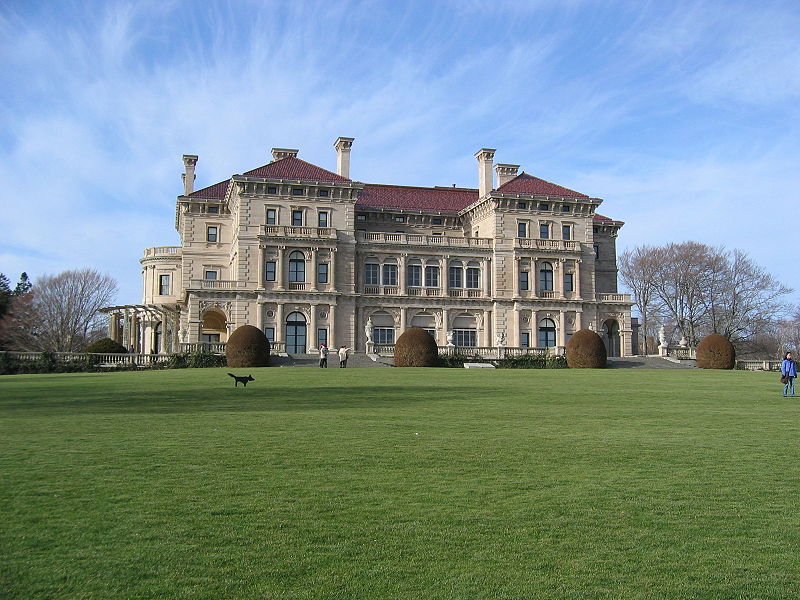
125,339 square feet and 70 rooms: $125,000,000 or $997/sq ft
The Breakers is another Gilded Age Vanderbilt mansion located in Newport, Rhode Island. Cornelius Vanderbilt II (George’s oldest brother) and his wife, Alice Claypoole Vanderbilt (née Gwynne), asked the same architect, Richard Morris Hunt, to design a summer home for them that would replace the one destroyed by fire at that location in 1892. Construction of the house began in 1893 and was completed in 1895.
The house was built in an Italian Renaissance style that imitated the 16th-century palazzi and the villas of Genoa, which in turn sought to revive the architecture of ancient Rome. Characteristic of the style were loggias, that is, covered exterior corridors with outer walls supported by columns and arches. The Breakers has these on the first and second floors, with the second floor having Ionic columns with volutes (scrolled ornamentation) at the top. Four columns define a triumphal arch design over the front doorway with its flanking windows, and ornamental stringcourses between the first and second floors, as well as circular decorative plaques carved with classical figures, adorn the mansion’s exterior.
The interior of the mansion has 70 rooms on five floors, including the basement and the attic. The rooms on the ground floor and the second and third floors are arranged around a vaulted central room, the Great Hall. On the first floor, there is an entrance foyer, both gentlemen’s and ladies’ reception rooms, the main staircase to the upper floors, a library, a music room, a communal sitting room, a billiards room, a dining room, a breakfast room, the pantry, the kitchen, and the lower loggia. On the second floor are the Vanderbilt’s bedrooms, various guest bedrooms, and the upper loggia. The third floor has eight more bedrooms as well as a sitting room decorated with walnut paneling in the style of Louis XVI. The north wing of the third floor was reserved for thirty smaller bedrooms that quartered domestic attendants. The attic contained more staff quarters and general storage, and the basement housed the laundry and staff restrooms.
Cornelius Vanderbilt, who was a workaholic, died prematurely of a cerebral hemorrhage at the age of 55 in 1899. His wife, Alice, outlived him by 35 years, passing in 1934. She left the house to their youngest daughter, the Countess Gladys Széchenyi, who lacked American property and was the only one of their children who had expressed an interest in The Breakers. In 1948, Gladys leased the high-maintenance property for $1 per year to the Newport Preservation Society. Glady’s daughter, Countess Sylvia Szapary, sold The Breakers and 90% of its furniture to The Newport Preservation Society in 1972 for a trifling amount, with the provision that the family be allowed to continue living on the third floor, which is not open to the public.
The Breakers is now the most-visited tourist attraction in Rhode Island, receiving about half a million visitors each year. The mansion is valued at around $125,000,000, which at 125,339 square feet, translates to $997 per square foot.
Mar-a-Lago (Trump)
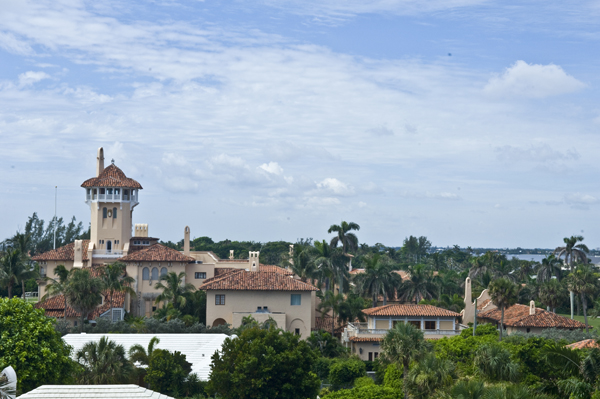
62,500 square feet and 126 rooms: $181,000,000 or $2,896/sq ft
Most famous as Donald Trump‘s home in Palm Beach, Florida, the Mar-a-Lago (Sea-to-Lake) resort and national historic landmark was built between 1924 and 1927 by the socialite and cereal-company heiress, Marjorie Merriweather Post. When she passed in 1973, she left the property to the National Park Service in the hope that it might be used for state visits or as a Winter White House. Unfortunately, the cost of maintaining the property, as well as the difficulty of making it secure for the President and for foreign dignitaries, led Congress to return the property to the Marjorie Merriweather Post Foundation in 1981.
The three Post daughters, including the actress Dina Merrill, were not interested in retaining the property, so it was listed to be sold for $20 million. Since they expected it to be sold right away, they did not maintain it, and the lack of interest in the property led to it languishing and decaying. Since the property was not selling, the city had approved its demolition to build smaller homes, something the family did not want to see happen, and which seems rather strange given that it had been declared a National Historical Landmark in 1980,
But then… in stepped Donald Trump.
Trump’s acquisition of the property is an interesting story. He learned about it after his efforts to purchase different properties for his family in Palm Beach were unsuccessful. He initially offered the Posts 15 million for Mar-a-Lago, but they refused the offer. Not to be deterred, Trump purchased the land between Mar-a-Lago and the ocean from Jack Massey, the former owner of Kentucky Fried Chicken, for $2 million, then declared his intention to build a home on it that would block Mar-a-Lago’s view of the beach. This threat reduced competition to such an extent that he ended up being able to buy the property for less than $8 million in 1985, which is about the same amount that Post spent to build it in the 1920s. In sum then, Trump got Mar-a-Lago and the property next door for less than $10 million. I guess you could say his approach illustrates the art of the comeback and the art of the deal. No hard feelings. It’s not personal; it’s strictly business.
But let’s get back to the house itself. Marjorie Merriweather Post financed the building with her husband, the financier E. F. Hutton, who listened to his wife while everyone else, apparently, was listening to him. She hired the American architect Marion Sims Wyeth to design the house and decorator Joseph Urban to design and finish the interior and exterior. The house, as originally designed, has 58 bedrooms, 33 bathrooms, a 29-foot long marble dining table, 12 fireplaces, and, interestingly, three bomb shelters.
After purchasing the estate, Trump did some extensive renovations, adding a 20,000 square foot ballroom. To offset the expensive upkeep of the property, he turned the estate into a private club in 1994, with his family maintaining a private residence in a separate and closed-off area of the house and grounds. The club has five clay tennis courts and a waterfront pool and has hosted concerts by Céline Dion and Billy Joel, among others. It also hosts yearly charity balls for the International Red Cross and the American Red Cross. According to financial disclosures, the Mar-a-Lago Club is generating healthy annual returns for the Trump family: $29.7 million from June 2015 to May 2016, $25.1 million for the 2017 calendar year, $22 million in 2018, and $21.4 million in 2019. Of course. taxes and operational expenses have to be deducted from these profits.
In another interesting turn—some would call it ironic—Trump has frequently referred to Mar-a Lago as his “Winter White House” and occasionally his “Southern White House,” which is precisely what Marjorie Merriweather Post had intended. In this capacity, during his presidency, Trump used Mar-a-Lago to host a variety of international dignitaries and leaders, including Chinese President Xi Jinping and Japanese Prime Minister Shinzō Abe.
At 62,500 square feet spread over 126 rooms, Mar-a-Lago is the second largest mansion in Florida (see Versailles House below), and the twentieth largest in the United States. With its $181,000,000 current price tag considered in relation to its square footage, it’s also the most expensive mansion in Florida, coming in at a pricey $2,896 per square foot.
San Simeon (Hearst Castle)
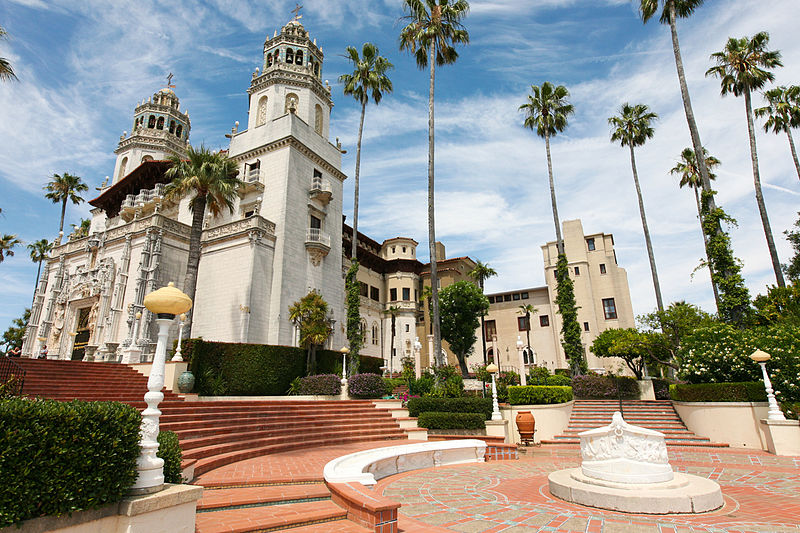
90,000 square feet and 165 rooms: $700,000,000 or $7,778/sq ft
The construction of San Simeon—better known as Hearst Castle—the hilltop estate of art collector and newspaper and media magnate William Randolph Hearst (1863-1951), began in 1919. Hearst hired California’s first licensed architect, Julia Morgan (1872-1957), to design his palatial mansion. It stands against the backdrop of the Santa Lucia Mountain Range, with magisterial views of the California coastline.
Hearst had dreamed for years of building a home similar to those he had seen on tours of Europe as a young boy, and he worked with Morgan for 28 years on the construction of his castle. The castle also became home to his vast collection of Old Master European paintings and sculptures, works by famous American artists, and collections of Greek, Roman, and Egyptians antiques, oriental rugs, tapestries, silver, furniture, and other artifacts.
Even while the castle continued to be built, Hearst used it as his primary residence and continually entertained the influential and the famous there, including political leaders like Winston Churchill, Calvin Coolidge, and Franklin Roosevelt, literary figures like George Bernard Shaw, wealthy businessmen like Howard Hughes, and movie stars and producers like Charlie Chaplin, Mary Pickford, Clark Gable, Greta Garbo, Jack L. Warner, Irving Thalberg, Buster Keaton, Joan Crawford, Carole Lombard, and many more.
One celebrity that did not get invited, however, was Orson Welles, whose film Citizen Kane (1941) was loosely based on Hearst’s life and work. The film traced the rise to power of the newspaperman Charles Foster Kane and the way that power corrupted him. Hearst hated the film, did not mention it in any of his newspapers or media outlets, and did his best to drive down the film’s box-office numbers. While it didn’t generate huge box office returns, the film is nonetheless regarded as a masterpiece. The only time Hearst and Welles met was, according to Welles’s account during an appearance on The Dick Cavett Show in the 1970s, in an elevator in San Francisco on the night of the movie’s premiere. Welles said he invited him to the opening, but Hearst maintained a surly silence, so he said to him, “Well, Mr. Kane would have come.” Awkward.
Hosting around 850,000 visitors each year, with its 56 bedrooms, 61 bathrooms, 19 sitting rooms, 127 acres of gardens, and remote majestic location, Hearst Castle would cost over $700 million to build today, a tidy sum that converts to $7,778 per square foot.
Shadow Lawn Mansion
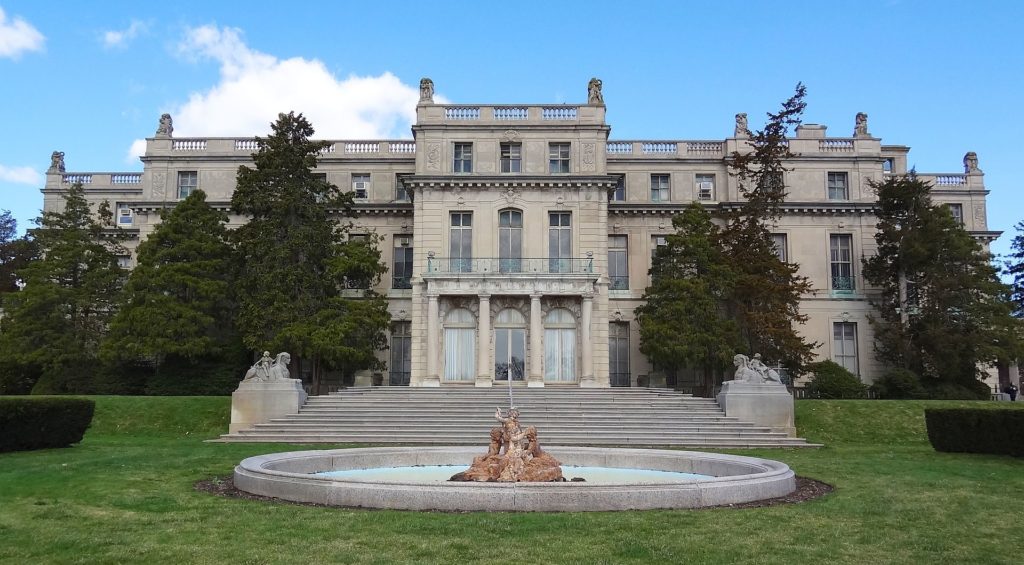
90,000 square feet and 130 rooms: $160,000,000 or $1,778/sq ft
Shadow Lawn Mansion, as we know it today, is the descendant of the mansion originally built on the same site in 1903. That house burned down in 1927 and was replaced by the current mansion in 1929.
The original home was built for the President of New York Life Insurance Company, John A. McCall (1849-1906) and his wife, Mary Ignatius Horan (1949-1935). This first house had a somewhat dubious history as the home of two financial felons and a President whose second term was finished surreptitiously by his wife after he had a stroke. But it was still a pretty impressive place.
McCall’s original mansion was a three-storey, 52-room house, situated on a small hill with a view of the ocean, in West Long Branch, Monmouth County, New Jersey. It was called “Shadow Lawn” for the clusters of large trees on the property that cast their shadows over the lawn in the heat of the day. It had two huge porticos, and the third floor boasted an atrium that had two pillared lookout towers that enabled a grand view of the estate and the ocean.
McCall didn’t get to enjoy his mansion for very long, however, since it turned out he was the first financial finagler living there to get convicted. In 1905, the same year that Murry (1858-1939) and Leonie (1865-1959) Guggenheim moved in next door, he was found guilty of bribing state legislators with New York Life Insurance Company money. He had to resign and sell the house to pay back the full amount. Shortly before his death the following year, he sold the property for $350,000 to New York attorney Myron Oppenheim.
Oppenheim bought the house with the intention of turning it into a country club, but his plans failed and he sold it within a year, this time for half a million, to another Wall Street rapscallion named Abraham White. White had been born Abraham Schwartz (which means “black” or “dark” in German) in Corsicana, Texas. He skipped town and changed his name to “White” after cheating his partner in the cotton business, then, in 1895, made $1.5 million almost overnight selling fraudulent “Cleveland bonds” to an unsuspecting public. With his ill-gotten newfound wealth, he became President of the DeForest Wireless Telegraph Company and purchased Shadow Lawn, ostensibly for his wife, whom he claimed “had the most beautiful voice in America,” though she refused to sing in public.
The Whites lived in the house for all of one year before Abraham was convicted of larceny and Shadow Lawn was foreclosed, though not before White had stripped out and sold all the silver chandeliers and doorknobs and stiffed the tradesmen for work that he had done on the house. He skedaddled back to Texas, by all accounts, before facing the consequences of his larceny conviction a couple years later, after which he seemingly disappeared from history.
After the Whites vacated the premises, Myron Oppenheim, because of his poor credit, repurchased the house under the name of his business partner, Robert L. Smith. He got it for $125,000 at the sheriff’s auction following the foreclosure and, for a very brief time, realized his dream of running what he called the “Brook Lawn Country Club.” It went bankrupt in short order. The property was then sold to its fifth owner in seven years, one Colonel Joseph Benedict Greenhut (1843-1918), who made most of his money selling whiskey.
By the standard to that point, Greenhut occupied the mansion for long time. He purchased it for $200,000, spent another $400,000 on renovations and landscaping and, in 1915, offered his home to President Woodrow Wilson (1856-1924) as the “Summer White House.” Wilson liked the idea and accepted the offer. It was as at Shadow Lawn, in 1916, that he learned of his re-election to what proved to be an ill-fated second term, during which he drew America into the First World War (prompting twice ex-President Theodore Roosevelt to wax poetic about “Shadows on the lawn at Shadow Lawn”) and, in 1919, had a stroke, at which point his second wife, Edith Bolling Galt Wilson (1872-1961) secretly managed the remainder of his second term.
Greenhut died in 1918 and Shadow Lawn was sold to Hubert Templeton Parson (1872-1940), the President of F. W. Woolworth & Co., for $800,000. Parson immediately bought more land, increasing the size of the estate to 108 acres, then spent another $1 million renovating it and an additional $1.25 million furnishing it. He enjoyed it for a few short years, then in January 1927, it burned to the ground.
Musical Interlude: Burning Down the House.
Not to be deterred, Parson replaced it with an even bigger house, the 130-room, 90,000 square foot mansion that we know today. It was designed by Philadelphia architect Horace Trumbauer and his assistant Julian Abele in the American Beaux-Arts style, which was derivative of the French neo-classical Beaux-Arts tradition. It cost $10.5 million to build at the time. It was completed in 1929, just before the stock market crash that catalyzed the Great Depression.
In keeping with the misfortunes associated with Shadow Lawn, the Parsons fell victim to the Wall Street crash. They managed to hold on to the property for another 10 years, but then lost it to the town for back-logged non-payment of property taxes amounting to $132,000. The home was resold for a mind-numbing pittance—one-hundred dollars!—and passed into municipal ownership. Hubert Parsons died the following year.
The home later served briefly as a military hospital, then in 1942, it was purchased from the city for $100,000 and became “Highland Manor,” a private school for girls. Monmouth University acquired the property in 1955 for $350,000 and made it the centerpiece of its campus, naming it “Woodrow Wilson Hall,” then later just Wilson Hall, and finally just the Great Hall, and so it remains to this day. In 1978, it was added to the National Register of Historic Places and in 1985 it was declared a National Historic Landmark.
The Great Hall includes 130 rooms on three main floors, as well as rooftop and basement rooms. The main portion of the building houses 96 rooms, among which were once seventeen master suites and nineteen bathrooms. Each of these master suites was decorated in the style of a different historical period, and the bathrooms varied as well, having gold- or silver-plated fixtures.
The 90,000-square-foot Shadow Lawn Mansion of 1929, were it to be built today, would cost $160,000,000, which translates to $1,778 per square foot.
Versailles House (Siegel)
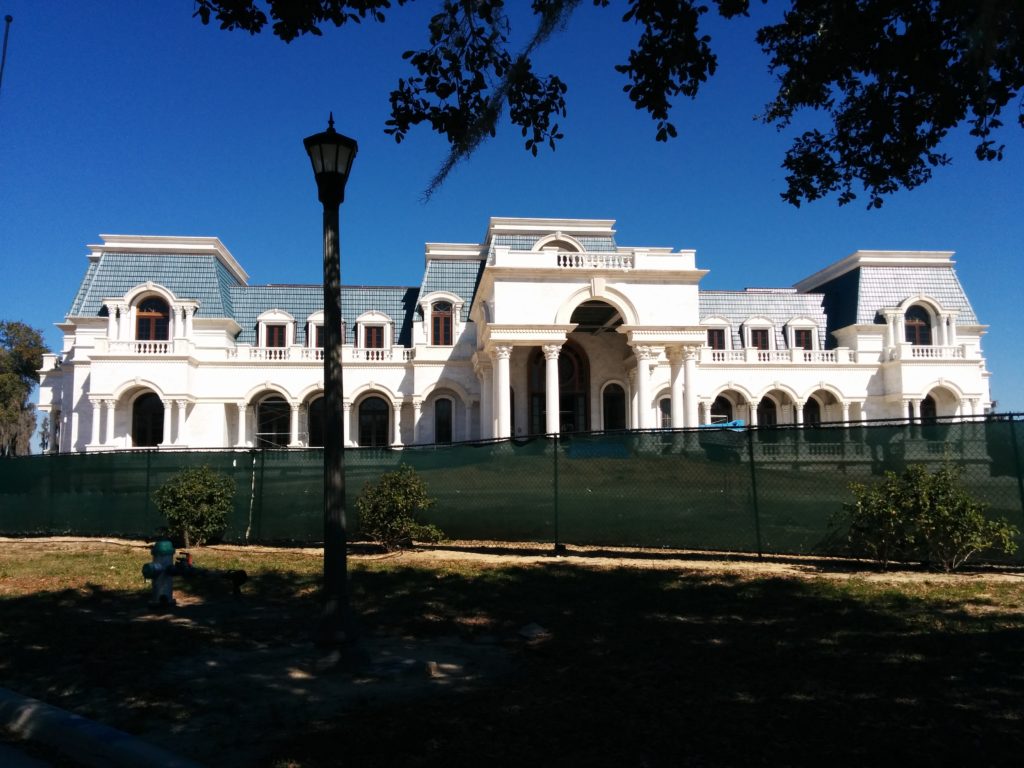
90,000 square feet and 55 rooms; $100,000,000 or $1,111/sq ft
Versailles House, a 90,000 square foot mega-mansion that has been under construction since 2004 on Lake Butler in Windermere, Florida, is the pride and passion of timeshare mogul David Siegel and his wife, Jackie, who was the subject of the 2012 documentary film by Lauren Greenfield titled “The Queen of Versailles.” The film was well-received by critics because it wasn’t just more mindless pandering to wealth-envy in the vein of the old Robin Leach series “Lifestyles of the Rich and Famous,” but a work of social criticism and reflection focused on the shallowness of self-glorification and the unenviable consequences of misdirected ambition and desire.
The building of the house has been a continuous soap-opera, the most notable episodes of which were the crisis and delays induced by the collapse of the housing market in 2008, and the sad death of the Siegel’s 18-year-old daughter, Victoria, from an accidental overdose of methadone and anti-depressants in 2015. The latter tragedy was the focus of a second documentary that her mother produced for YouTube in 2019 called, not surprisingly, “The Princess of Versailles.” In the wake of their daughter’s death, the Siegels have redirected some of their efforts toward addressing the opioid crisis.
Versailles House is being constructed on top of a man-made hill on ten acres of lakefront property and is now projected to be completed sometime in 2022. In some ways, its excesses are characteristic of Ambani home, Antilia. In addition to its fourteen bedrooms, nine kitchens, numerous bathrooms, and private elevator in the master bedroom closet, it will have three indoor and two outdoor pools, a video arcade, a two-storey movie theater with a balcony that was inspired by the Paris Opera House, a second smaller private movie theater, a ballroom with the capacity for 1,000 people, a wine cellar for 20,000 bottles of wine, a large aquarium for exotic fish, a yoga studio, two tennis courts, a commercial-grade bowling alley with two lanes, a baseball diamond, and a large formal outdoor garden. The exterior walls are made of precast concrete covered with a Pavonazzo marble veneer, and the doors and windows, at the cost of $4 million alone, are made from some of the last Brazilian mahogany wood available after the ban on trade in big-leaf mahogany by the Brazilian government in 2001.
The 55-room, 90,000 square-foot mansion has an estimated completed cost of about $100 million dollars, which translates to a avery healthy $1,111 per square foot.
Xanadu 2.0 (Gates)
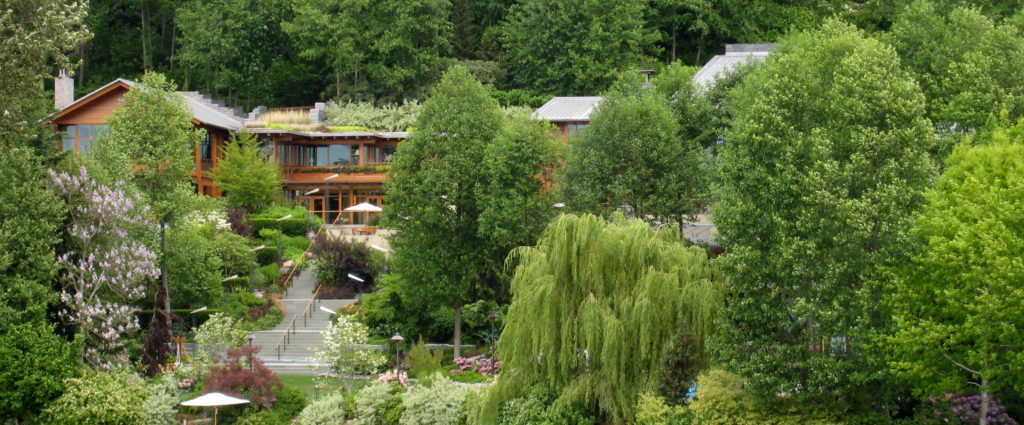
66,000 square feet and over 50 rooms: $150,000,000 or $2,273/sq ft
As of September 2021, Bill Gates, recently divorced from his wife, Melinda Gates, has slipped to #5 on the Forbes Real-Time Billionaires List, which keeps track of the fluctuating fortunes of the world’s billionaires. Even so, and unsurprisingly, the Microsoft founder’s home, located in Medina, Washington, is one of the most opulent and technologically sophisticated in America.
Built into a hillside overlooking Lake Washington, Gates’ earth-sheltered mansion is called “Xanadu 2.0” after the fictional home of the Charles Foster Kane in Orson Welles‘ critically acclaimed film, Citizen Kane (see the discussion of Hearst Castle, above). Of course, Welles got the name from Samuel Taylor Coleridge‘s poem, Kubla Khan, quoted in part at the beginning and the end of this article. The name seems a strange choice given its dysfunctional associations.
When it was originally built, the home took seven years to complete and cost a total of $63 million. When it was built, it used over half a million board-feet of lumber from 500-year old Douglas fir trees and employed 300 construction workers, over 100 of whom were electricians. Having more than doubled in value since its construction in the 1990s, Gates pays well over a million dollars each year just in property taxes to own and live in the house.
Let’s have a brief study in the excess afforded by phenomenal wealth. Gates’ home has 7 bedrooms, 24 bathrooms, 6 kitchens, multiple staircases and an elevator, a 1.000 square-foot dining room that seats 24 people, a 1,500 square-foot Art-Deco-style home theater with plush seats for 20 people along with additional couches and a large popcorn machine, a huge reception hall for up to 200 guests with a large limestone fireplace on one wall and a 22-foot wide video screen on the other, a 2,100 square-foot library with a dome roof and two secret bookcases, one of which conceals a hidden bar, a trampoline room with a 20-foot ceiling, a 2,500 square-foot fitness area that includes a steam room and sauna as well as separate men’s and women’s locker rooms, a 60-foot pool in a separate 3.900 square-foot building that also includes a locker room with four showers and two baths, multiple garages that hold a total of 23 cars, the largest of which is an underground structure made of concrete and stainless steel that will hold 10 cars, and a separate 1,900 square-foot luxury guest house.
Other features and extravagances of the home include the fact that, when guests arrive, they can be given an electronic pin that interacts with sensors located all over the house. Guests can enter into their pins the temperature and lighting preferences they find most comfortable, then, as they move throughout the building, the settings in the house automatically adjust to their preferences. Speakers are also hidden behind the wallpaper in each room so that musical choices can follow you as you move throughout the house. Situated around the house are also $80,000 worth of computer screens that can be made to display favorite paintings or photographs. In the library, you will also find the Codex Leicester, a collection of the scientific writings of Leonardo da Vinci, that Gates bought at an auction in 1994 for almost $31 million, As for real art, you will also find Winslow Homer‘s famous painting Lost on the Grand Banks, a work that Gates acquired at auction in 1998 for a record $30 million.
At 66,000 square feet spread over more than 50 opulent rooms infused with the latest technology and conveniences, Gates’ mansion clocks in at an extravagant $2,273 per square foot.
Warner Estate (Bezos)
13,612 square feet and over 25 rooms: $175,000,000 or $12,856/sq ft
The richest man in the world, Jeff Bezos, founded the e-commerce company Amazon in 1994 working out of the garage of his 1,540 square-foot home in Bellevue, Washington. He is so rich today, in fact, that his ex-wife, MacKenzie Scott, whom he divorced in 2019 after 25 years of marriage, is the world’s 22nd-richest person, just a hair (sorry Jeff) behind billionaire Michael Bloomberg.
Needless to say, Bezos (whose birth name was Jeffrey Preston Jorgenson) doesn’t work out of his garage any more. When he isn’t traveling to space in his own rocket with his commercial aerospace venture Blue Origin, among his many homes is a posh residence in the upscale Beverly Hills neighborhood of Benedict Canyon,
Originally built in 1930 for Jack L. Warner, the Canadian-American co-founder of Warner Bros. Entertainment Inc., who died in 1978, the house was occupied by his widow, Ann Warner, until her death in 1990. at which point the house was bought by business magnate, music producer and record label owner, and film studio executive, David Geffen. Geffen sold the home to his friend, Jeff Bezos, for a record $165 million in February of 2020. In the last year and a half, it has increased in value by another $10 million. Bezos has also been buying up surrounding properties to increase his privacy.
Back in its heyday, the Warner Estate was regularly host to a who’s who of golden-age Hollywood celebrities like Errol Flynn, Olivia de Havilland, Jimmy Stewart, Audrey Hepburn, and Marilyn Monroe. Warner hosted celebrities from other walks of life at his mansion too, including businessmen like Howard Hughes, and famous scientists like Albert Einstein.
Geffen originally purchased the estate for $47.5 million, then proceeded to pur another $45 million into the property. Located on nine acres, the mansion has a Georgian Style design. With six magestic pillars in the front and a large circular drive with a fountain, it’s façade is in some ways reminiscent of the White House (see below).
The mansion has vaulted wood-panelled entry with a gargantuan period chandelier from the 1920s, a cantilevered staircase, eight bedrooms, nine bathrooms, a large dining room, a huge living room with a cut-glass chandelier and a large fireplace, a movie theater, a library, a sun room, and an extensive bar. Parts of the mansion have flooring that was once owned by Napoleon.
The estate is surrounded by massively tall hedges and contains manicured, terraced gardens, a nine-hole golf course, a tennis court, an outdoor p0ol with a hot tub, a tree nursery, two ponds, three greenhouses, and two guesthouses. The compound has a motor court that will hold over twenty vehicles and has its own service garage and gas pumps.
The central mansion on the Warner Estate is by no means the largest of the many mansions of the ultra-rich we have considered, but it is one of the pricier ones. With a comparatively modest square footage of 13,612, yet a whopping price tag of $175 million, Bezos’s home comes in at a staggering $12,856 per square foot, making it by far the most expensive private mansion by this measure.
White House
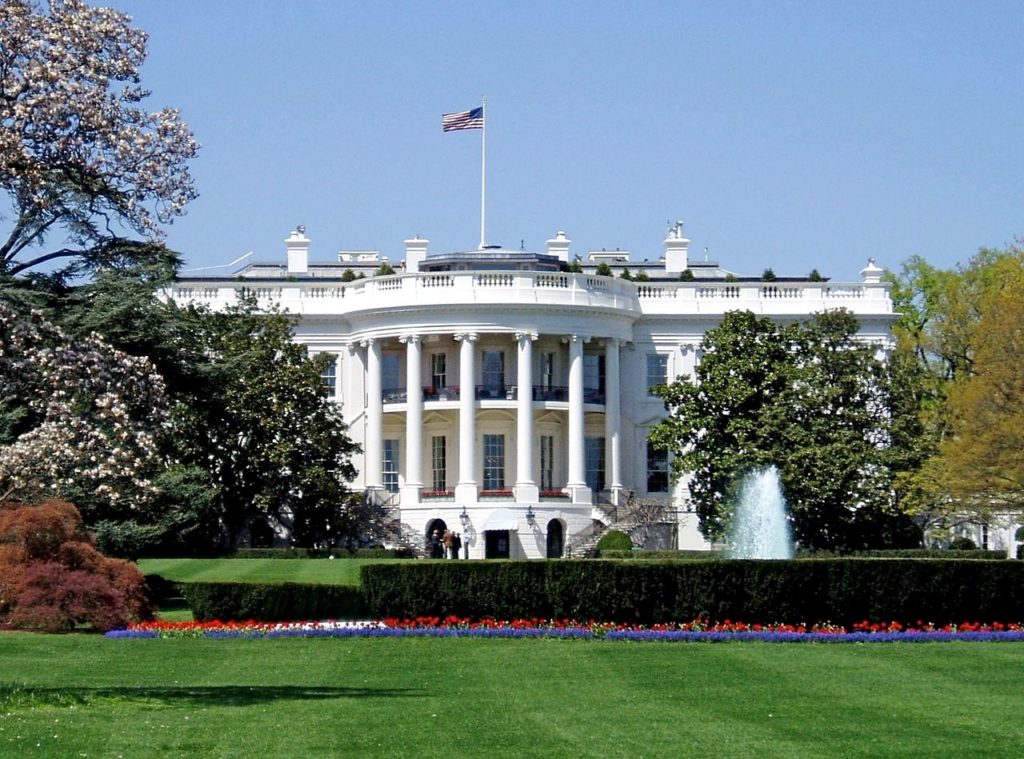
55,000 square feet and 132 rooms: $439,428,800 or $7,990/sq ft
By far the most august residence that was never the abode of royalty is the White House, the home, ever since the second to hold the office, President John Adams, to forty-five Presidents of the United States.
Located at 1600 Pennsylvania Avenue in Washington, D.C., the White House was designed in the neoclassical style by the Irish-born architect James Hoban (1755-1831). The original structure was built between 1792 and 1800 using Aquia Creek sandstone that was then painted white. At Thomas Jefferson’s initiative, architect Benjamin Henry Latrobe (1764-1820), who was one of the major architects for the U.S. Capitol Building, was hired to add colonnades on each wing of the structure to hide the view of storage areas and horse stables.
During the War of 1812 in North America, which ran through 1815, British troops burned buildings in the Capitol, and the White House was one of the buildings set ablaze on August 24, 1814. The interior was destroyed and much of the exterior was charred. The project of reconstruction was begun immediately and President James Monroe moved into the Executive Residence in October 1817. The sourth portico was constructed in 1824, and the north portico in 1830. Running water was installed in 1833, and central heating in 1840.
Prior to the building of the West Wing during the adminstration of President Theodore Roosevelt, the presidential staff did their work at one end of the second floor of what is now the Executive Residence. Roosevelt found this arrangement inadequate for his family of six children and his staff, so in 1902 he began a major renovation that added what is now known as the West Wing. The West Wing houses the President’s offices and Cabinet Room. It replaced the greenhouses and stables originally located there. Congress approved over half a million dollars for the renovation, which was planned and brought to fruition by the New York architectural firm McKim. Mead, and White. It was Teddy Roosevelt, 1901, who gave the White House its official name.
Roosevelt’s successor, President William Howard Taft, expanded the West Wing and added an Oval Office designed by the American architect Nathan C. Wyeth (1870-1963). President Herbert Hoover had the West Wing rebuilt early in his presidency, but seven months after it was finished, an electrical fire that started in the attic caused significant damage and destroyed a lot of documents. Not to be deterred, Hoover had the West Wing rebuilt again, and added air conditioning.
The final major reorganization of the West Wing took place a short time later during the administration of President Franklin D. Roosevelt. Finding the size and layout awkward, he had the New York architect Eric Gugler (1889-1974) redesign it to create additional space without making the building larger on the outside. To accomplish this, Gugler excavated a full basement and added subterranean offices under the lawn, and added an unobtrusive storey on top.
During the administration of President Harry S. Truman, the load-bearing external walls of the White House, and the internal wood beams, were found to be close to structural failure, necessitating some major work. Truman had the requisite interior rooms entirely dismantled and a new interior load-bearing steel frame constructed inside the walls. While the renovations were being done, he also had the Truman Balcony added on the second level exterior. The interior rooms were rebuilt once the structural remedies were in place.
The White House complex today includes five main parts: the Executive Residence, the West Wing, the East Wing, and two structures not on the White House grounds, the Eisenhower Executive Office Building (formerly the State Department, but now the home of offices for the president’s staff and for the vice president) and Blair House, a guest residence. The Executive Residence of the White House has six stories: the Ground Floor, State Floor, Second Floor, and Third Floor, and then underground, a two-storey basement.
In total, the White House proper contains 132 rooms, 35 bathrooms, and (as mentioned) six levels in the Executive Residence. It has 412 doors, 147 windows, 28 fireplaces, 8 staircases, and 3 elevators. The White House kitchen is capable of serving dinner to 140 guests and can manage hors d’oevres for over 1,000 people.

Image Credit: Wikimedia Commons
The interior floor space of the White House covers 55,000 square feet. Estimates of how much it would cost to build it today vary widely. Given its location in Washington, D.C., however, if it were for sale today, Zillow estimates its market value to be $439,428,800, which translates to a very healthy $7,990 per square foot.
* * * * * * * * *
This ends a fascinating journey through the extravagance and excess of the palaces of royalty and the mansions of the ultra-rich. While the royals, in most cases, dominate on the level of raw square footage, when it comes to cost per square foot, the ultra-rich more than hold their own.
…Weave a circle round him thrice,
And close your eyes with holy dread,
For he on honey-dew hath fed,
And drunk the milk of Paradise.
* * * * * * * * *
One thing is perfectly clear from our considerations, however: wealth does not bring happiness.
Vanity of vanities, says the Teacher (Ecclesiastes 5:10-15, NIV):
Whoever loves money never has enough;
whoever loves wealth is never satisfied with their income.
This too is meaningless.
As goods increase,
so do those who consume them.
And what benefit are they to the owners
except to feast their eyes on them?
The sleep of a laborer is sweet,
whether they eat little or much,
but as for the rich, their abundance
permits them no sleep.
I have seen a grievous evil under the sun:
wealth hoarded to the harm of its owners,
or wealth lost through some misfortune,
so that when they have children
there is nothing left for them to inherit.
Everyone comes naked from their mother’s womb,
and as everyone comes, so they depart.
They take nothing from their toil
that they can carry in their hands.
